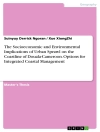In the field of risks and crises, both the access to relevant information and its circulation are seen as crucial factors. Based on a new integrated theoretical model focusing on the stakeholder, the book proposes analysis of information reformulation and circulation in risk environments and crisis situations.
Simply circulating the information does not mean that it will be picked up by those who could benefit from it. This has been amply demonstrated by the various crises and catastrophes that have shaken the planet in recent years. In order to be able to deal with risk situations and crises, it must be possible for information – when it circulates – to be understood and interpreted by a wide range of stakeholders, working in fields such as health and natural or environmental risks. By observing closely, in three very different situations, the way in which information is gathered, processed, distributed and used, this book examines the countless reformulations, redefinitionsand even reorientations to which all information is subjected. This multiple reformatting, at least according to the hypothesis put forward in this book, is an important element in ensuring that the information produced circulates and reaches those for whom it is intended. The intention is then to analyze the way in which information circulates in situations of risk and crisis. In order to do it, the authors propose a new theoretical model based on different approaches. This model is anchored in the trend of research that has been oriented towards a wider understanding of risks and their territorial and social consequences. These ideas question the approach to risk which focuses primarily on technical aspects and probability. The model also draws from approaches to risk that focus on the stakeholders involved in the debates and the need for an integrated vision of risks. Risks are thus considered heterogeneous, plural and transcalar. The information flow about risks was studied first in the SHOC Room of the World Health Organization (WHO) in Geneva, a central place through which passes all information destined to managing world-wide epidemic risks. Then the research team monitored the constitution and the reception of a field library about risks management and reduction sent to Madagascar, an island systematically hit by cyclones. This following process has permitted the analysis of information dissemination during a crisis situation. The third field work was done in Cameroun to observe the use and transmission of information in two NGO specializing in sanitary risks prevention using traditional and biomedical conceptualization of health and illness. The book ends with a practical tool to assess and help the information circulation in risk and crisis situations.
विषयसूची
From the Contents: Risk and Information: for a new Conceptual Framework.- A Contemporary Look at Risks: Risks are Plural and Transcalar.- Information as a Process.- Definitions, Classifications and Models.- Reviewing Risk Categories.
लेखक के बारे में
Valerie November, Ph.D., is CNRS Research Professor and is working at the Techniques, Territories and Society Lab (LATTS), Ecole des Ponts Paris Tech. Between 2006 and 2011, she worked as Swiss National Science Foundation Professor at Ecole Polytechnique Federale of Lausanne (EPFL). Her research focuses on risk management in many different fields (natural, environmental, technological, urban), with an approach that mixes human geography and sociology of science and techniques. She published “Habiter les territoires à risques” (2011) and the catalogue of the art-science-society exhibition called “Risk in Sight” that she commissioned (2012).
After many migratory movements between Switzerland and Canada, Yvan Leanza, Ph.D., is a full professor in the School of Psychology, Laval University (Québec City) where he teaches cross-cultural psychology and intervention, and leads the “Psychology and Cultures” lab. His research focuses on working with interpreters and relations to the (culturally different) other in healthcare settings and on sleep in a cross-cultural perspective. He is a founding member and the director of Alterstice – International Journal of Intercultural Research. He has edited or authored books on migrant and minority integration processes, and on the relation to the (culturally different) other in pediatrics. He is one of the authors of the only systematic review of interpreting qualitative studies (published in Patient Education and Counselling 91, 2013) and of a chapter on working with interpreters in mental health settings (in Kirmayer, L. et al., 2014, Cultural Consultation, New-York: Springer).












